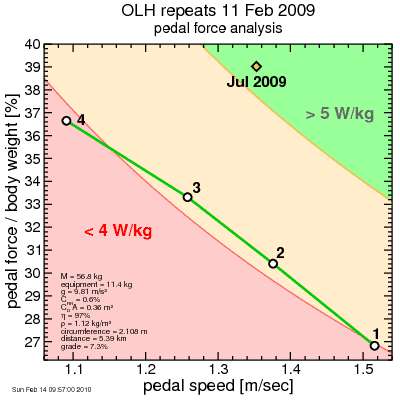Old La Honda repeats with Sport Velo
 At the first day of the SportVelo training camp, Dan Smith had us do four Old La Honda repeats. The goal was to start slow and get faster each time. I was able to accomplish half of this, anyway: I started slow.
At the first day of the SportVelo training camp, Dan Smith had us do four Old La Honda repeats. The goal was to start slow and get faster each time. I was able to accomplish half of this, anyway: I started slow.My approach was progressive gearing. 34/26, 34/23, 34/21, 34/19. I'd set my PR in July in 36/18. At the same cadence as my PR, this last gear would have gotten me to the top in 18:48. That's a typical good Noon Ride time for me, well at least it was last summer, on my Ritchey Breakaway, which has been my training bike of choice.
Instead my legs were already feeling the 34/26 effort, the 34/23 felt harder, the 34/21 a struggle, and despite a caffeinated Gu to fuel my motivation, I basically collapsed on the final rep. I hate making excuses for myself, so I won't. But if I cloned myself and had to give myself advice, I'd probably tell my alternate self that the 6 running repeats up Potrero Hill I'd done 1.5 days earlier had blunted my legs. I've never ridden well so soon after a hard run. But as I said, I hate making excuses.
I'd ridden the set without my Powertap, so instead used the power-speed equations to calculate my power, pedal force, and then from cadence and crank length I calculated my pedal speed. Power is the product of pedal speed and force, so constant power is a hyperbola on this plot. The repeats are numbered. My July result is indicated with a diamond.

My pedal speed was fine, my force was just way off. On the last rep, I just couldn't produce the increase force required to compensate the reduced pedal velocity resulting from the bigger gear, and power drooped. I was obviously a long, long way from July.
It's often said that cycling is dominated by aerobic capacity, that muscle strength has little role. However, I feel this is misleading. Consider for example, this study by Mauger, Jones, and Williams shows that acetaminophen works better than a placebo at allowing athletes to tolerate higher levels of blood lactate at the same level of perceived exertion and to as a result ride a faster time in a 10 mile time trial. Certainly acetaminophen has no effect on aerobic capacity. It's simply a matter of pushing your muscles harder.
So cycling may be an "aerobic" event, but the aerobic system still can only fuel the muscles, which need to do the actual work. So I shouldn't be too discouraged by my Old La Honda times. My body just isn't able to handle hard runs and recover within 24 hours. That certainly takes a toll.

Comments